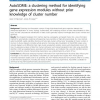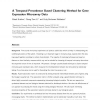774 search results - page 1 / 155 » Visualization methods for statistical analysis of microarray... |
BMCBI
2005
14 years 5 months ago
2005
Background: The most common method of identifying groups of functionally related genes in microarray data is to apply a clustering algorithm. However, it is impossible to determin...
BMCBI
2010
14 years 6 months ago
2010
Background: Clustering the information content of large high-dimensional gene expression datasets has widespread application in "omics" biology. Unfortunately, the under...
BMCBI
2010
14 years 6 months ago
2010
Background: Time-course microarray experiments can produce useful data which can help in understanding the underlying dynamics of the system. Clustering is an important stage in m...
BMCBI
2007
14 years 6 months ago
2007
Background: Regulation of gene expression is relevant to many areas of biology and medicine, in the study of treatments, diseases, and developmental stages. Microarrays can be use...
BMCBI
2008
14 years 6 months ago
2008
Background: Currently, clustering with some form of correlation coefficient as the gene similarity metric has become a popular method for profiling genomic data. The Pearson corre...


